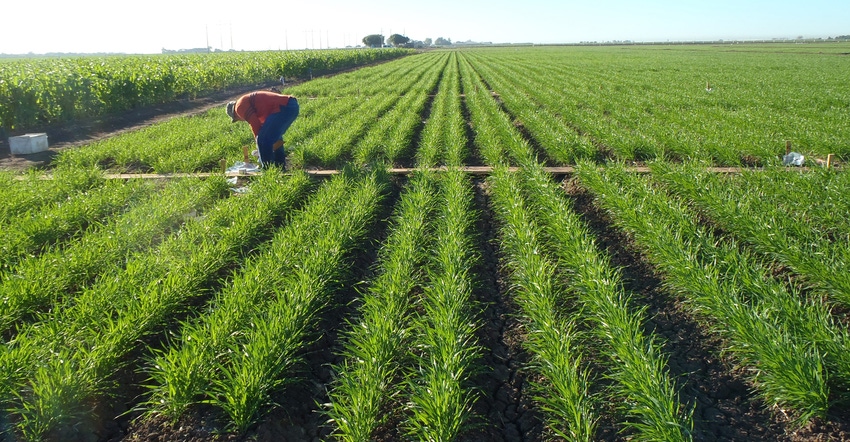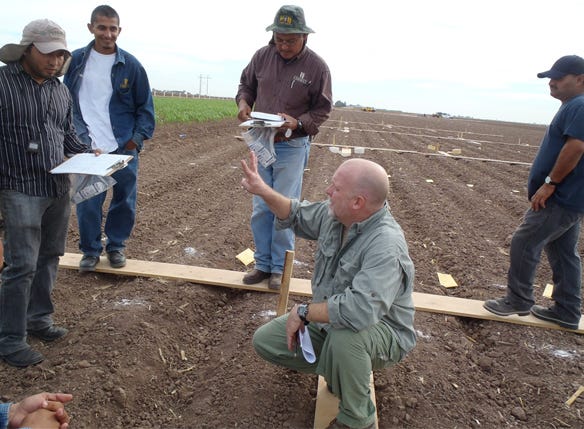February 8, 2017

Through the help of multiple partners, a small project that started in the early 2000s at the Kellogg Biological Station Long-term Ecological Research near Hickory Corners has turned into an international effort to help Mexico reduce its greenhouse gas emissions.
In the early 2000s, LTER’s Phil Robertson, a Michigan State University plant and soil professor, began researching how different rates of nitrogen fertilizer applied to corn affected soil emissions of the greenhouse gas, nitrous oxide. This gas is emitted from row-crop agriculture, and is about 300 times more potent than carbon dioxide with respect to global warming. In 2006, the Electric Power Research Institute awarded funding to Robertson and colleagues to expand their research to commercial farms in Michigan. This took a team of MSU researchers across the state to work with corn producers to investigate how yield and nitrous oxide responded to different nitrogen fertilizer rates.
Protect climate while cutting N use
Findings on the farm sites validated results from the LTER experimental site, namely that nitrous oxide emissions increased exponentially with increasing nitrogen fertilizer rate. That is, after enough nitrogen was applied to meet the needs of high-yielding corn, nitrous oxide emissions dramatically increased. This has the potential to help both farmers and the climate, as reducing nitrogen fertilizer inputs without taking a yield hit saves farmers money and reduces the potential for excess nitrogen to pollute the air, land and water.
The findings from this research had been recently published when Robertson traveled to China with a group of colleagues that included Ivan Ortiz-Monasterio, principal scientist at the International Maize and Wheat Improvement Center (commonly called by its Spanish acronym CIMMYT, for Centro Internacional de Mejoramiento de Maíz y Trigo).
As they traveled the Chinese countryside, Robertson and Ortiz-Monasterio discussed the importance of this work and the potential for farmers to be paid for reducing nitrogen fertilizer rates via carbon offset markets. Programs are in place that allow farmers to convert their nitrous oxide emissions reductions to equivalent units of carbon dioxide. These can then be traded as carbon credits on environmental markets to generate income.
Both Robertson and Ortiz-Monasterio agreed to take the KBS research international. They discussed how to translate the Michigan corn work to Mexico’s Yaqui valley, where Ortiz-Monasterio leads CIMMYT research with farmers to improve food security and lessen agriculture’s impact on the environment.
The Yaqui valley, on Mexico’s northwest coast, is one of the country’s major breadbaskets. The majority of the valley is planted to spring wheat that is irrigated and heavily fertilized, conditions where nitrous oxide emissions had been shown to be very large and where large emission reductions might be possible with moderate reductions in nitrogen fertilizer inputs. Researching nitrous oxide could help Mexican farmers improve their livelihoods because it might help save money on fertilizer costs and farmers could also be paid via the carbon market. Reducing nitrous oxide emissions would also help mitigate climate change, ensuring the sustainability of their farms for future generations.
Michigan corn same as Yaqui Valley wheat?
Upon returning to Michigan, Robertson worked with LTER researcher Kevin Kahmark to design and implement the Mexican study. The goal was to find out if nitrous oxide emissions in Yaqui Valley wheat fields respond to fertilizer in the same way as in Michigan corn. They wanted to see if the same non-linear response was produced with increasing fertilizer as they did in Michigan.

SPREADING KNOWLEDGE: Kevin Kahmark teaches greenhouse gas techniques and sampling strategies to researchers in the Yaqui Valley.

Before long, Kahmark was flying to Mexico to help set up the experiment and teach CIMMYT researchers how to sample greenhouse gases.
“Our Mexican colleagues were so kind and hospitable to me and seemed genuinely grateful for our interactions,” says Kahmark about their early interactions. “From my perspective, being able to share our research experiences and knowledge with them was a privilege, as was the opportunity to see how other communities are conducting research and thinking about sustainable agriculture.”
Over the next two years, CIMMYT researchers collected gas samples from their fields into vials, many of which Kahmark hand-carried to KBS for analysis.
Traveling between countries with vials and equipment proved to be sometimes eventful for Kahmark. language barriers and suspicious looking gas vials led to awkward encounters with border and military police, and the “loss” of a number of samples. Fortunately, the vast majority of vials made it across the border, and to date Kahmark has analyzed over 34,000 samples of greenhouse gases from Mexico.
Research goes countrywide
Another fortuitous meeting took the project to another level. In 2014, Robertson met Daniel Lapidus, a USDA International Agricultural Development specialist at a Coalition on Agricultural Greenhouse Gas meeting in Washington, D.C. In discussing the CIMMYT project, Lapidus realized the potential to expand the Yaqui Valley work to other sites in Mexico. He was able to help leverage USDA Foreign Agricultural Service funds to conduct workshops to support a larger initiative that included multiple nitrogen gradient studies throughout Mexico.
Kahmark and Neville Millar, LTER science coordinator, are now conducting workshops near Mexico City to measure greenhouse gases. The expectation is that nitrous oxide data from multiple sites around Mexico will help to generate an even more accurate picture of nitrous oxide emissions in Mexican grain crops. This information could then be used by policymakers and advisers to develop improved management practices or other incentives to help meet Mexican greenhouse gas mitigation goals. Eventually, the researchers will share results with farmers to help them improve nitrogen fertilizer management to reduce nitrous oxide emissions from agriculture, and in doing so, enable farmers to improve their bottom line while helping the environment.
Kahmark is completing the analyses of Mexican greenhouse gas samples, while Millar works to analyze the data and publish results. Early evidence shows an exponential response of nitrous oxide to increasing nitrogen fertilizer in spring wheat, remarkably similar to the results from corn in Michigan.
“I never imagined, back in 2000, where this project would lead” says Robertson. “Being able to leverage our work in Michigan, develop relationships with our Mexican colleagues and help to inform Mexican research has been a rewarding experience.”
Source: KBS Long-term Ecological Research Program
You May Also Like




